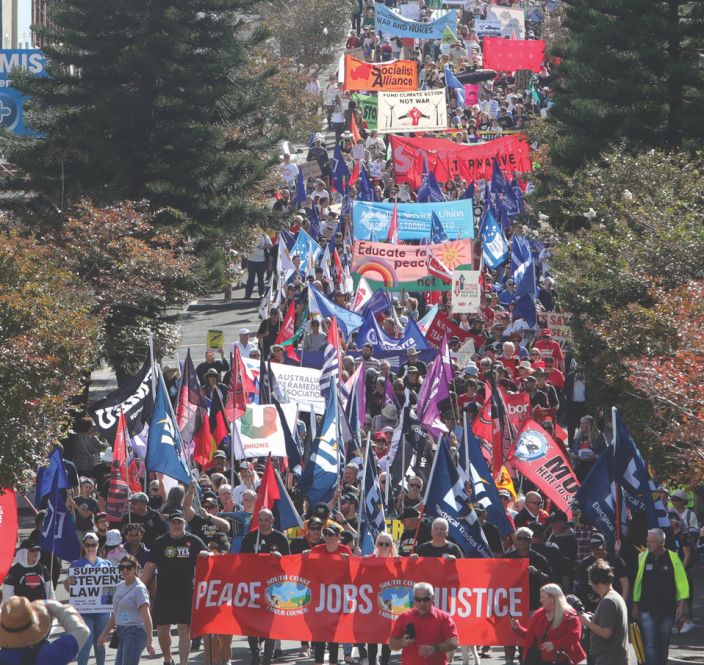
Former IEUA Federal Secretary Chris Watt reflects on the history of peace activism by the IEU, as the AUKUS deal once again galvanised unions in a fight for peace and a nuclear-free world.
When I started teaching in 1982, the ‘doomsday clock’ was at four minutes to midnight (the story of the clock itself is central in mapping the geo-political issues that pushed us historically and currently closer to a nuclear armageddon).
Within two years it had moved to three minutes to midnight, as close as it had been since 1953. There was a general sense of concern internationally about the build-up of nuclear weapons not only in the USA and the USSR but also other nation states that had been developing their own arsenals.
This tension was only heightened by the apparently nation-state agreement to the doctrine of MAD (Mutually Assured Destruction) that would supposedly prevent any launch of weapons because of the immediate response from the other side that would plunge the world into a nuclear winter. In other words, the world sat watching and hoping that no one was insane enough to launch first.
Unfortunately, the rhetoric in the last couple of decades seems to suggest that it would be possible to have a contained nuclear exchange. This leads us to the astonishing situation that during the last decade, despite almost 30 years of relative improvement in the assessment of our potential nuclear folly that the clock shifted in 2015 to three minutes to midnight again and has, over the last couple of years, shifted closer and closer to midnight and for the last three years has sat at 100 seconds to midnight, a level never before reached.
In the middle of this blundering and stumbling madness it appears that Australia is seriously considering contributing to global nuclear instability by permitting nuclear capacity submarines into Port Kembla.
In the 1980s, the nuclear threat was probably the gravest environmental concern that was perceived (despite any number of experts having talked about climate change and environmental degradation issues for many decades). There was an understanding of the utterly catastrophic and irretrievable outcomes of the notion of a nuclear winter, (If you haven’t read Cormac McCarthy’s The Road, do so now!)
There was nevertheless an optimism that ‘the people’ could influence the political agenda in the 1980s and a sense of global community, that we could achieve a more peaceful planet. The peace movement in the 1980s was inextricably linked to the nuclear disarmament movement.
As educators, IEU members (then the ITA in NSW) saw both an opportunity and responsibility to be part of the education program about what was wrong with the doctrines of the time and also the linkage with the broader environmental movement, including but not limited to the nuclear fuel cycle, the degradation of mining lands, the overriding of land rights of our First Nations Peoples, the issue of nuclear waste and its long-term impact on the environment.
Nuclear threat, moral threat
It was also interesting that at that time many groups affiliated to religious bodies saw the nuclear threat as a moral threat and these groups worked closely with organisations such as People for Nuclear Disarmament (of which Teachers for Nuclear Disarmament was an offshoot formed by activists from the ITA and Teachers Federation) (PND precursor was AICD - Association for International Cooperation and Development ) This religious support influenced the emergence of the Palm Sunday rallies in Sydney as part of the peace and disarmament annual calendar.
It is tragic that we are still having to fight these same battles, more than 40 years since ITA correctly saw the need to raise awareness and agitation among its membership and the fundamental threat to our future.
It is perhaps even more tragic that, probably due to the unquestionable existential threat facing us from the broader environmental issues around climate change, that many of us have taken our eyes off the ball in relation to the continuing and increasing threat from nuclear weapons and the real concern that a ‘targeted’ exchange in the current Russia-Ukraine war could actually be being talked about as a real option.
The IEU has had a proud and courageous history of speaking up and acting on matters of moral questions and ethical dilemmas. Our members work in workplaces that are underpinned by strong moral codes, usually based on a religious dogma (including many faith groups who were strongly and publicly committed in the 1980s to action against the nuclear weapons agenda).
Our members know what it means to look out for others. Our members know that bringing the collective to bear is not only important, but it is right and our responsibility. In 2023, it is once again right for IEU members to say no to any political agenda that increases international instability, particularly when that action leads to an increase in the risk to all peoples of the planet through the promotion and acceptance of nuclear weapons as a ‘reasonable’ defence option.



































































































































